 静谧形态琳琅评论: Nox
静谧形态琳琅评论: Nox评价: 力荐
Zilan Qian is a fellow at the Oxford China Policy Lab and an MSc student at the Oxford Internet Institute.
This “AGI Bar” recently opened in Shanghai, where people openly poke fun at the hype surrounding AGI by stating that this bar is “all about bubbles.”
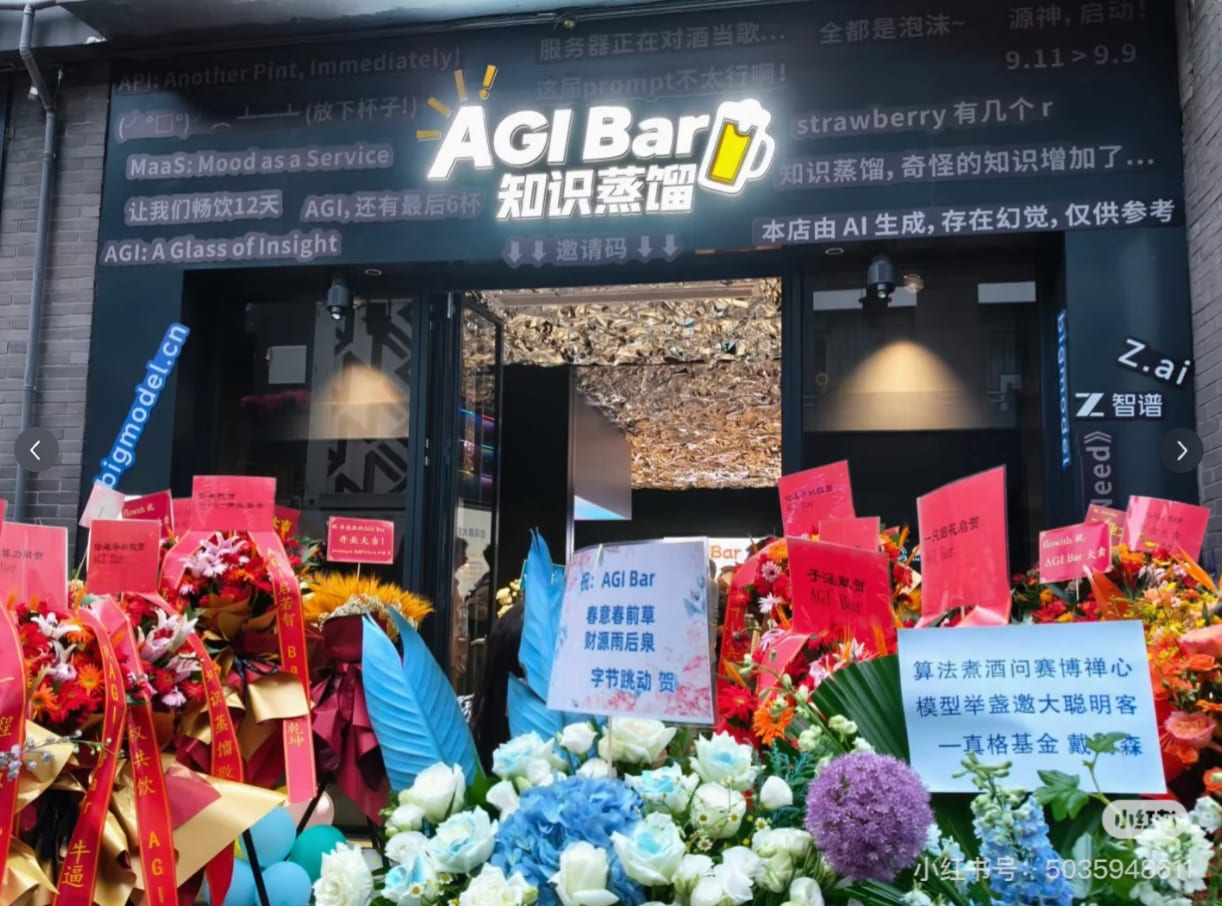
Not many people would point to this bar and say that China is racing towards AGI. Otherwise, the U.S. has zero chance of winning, because AGI is diffused to even bars in China. AGI is a buzzword for business in this context, period.
This is the consideration needed for people who want to know whether China is taking AGI seriously. Before you ask anyone who works on China and AI how AGI-pilled China is, ask yourself two questions: what do you mean by AGI, and who do you mean by China?
This post provides one piece to the picture by looking into a giant AGI wiki made by an open-source community in China. As this piece will show that, for AI hobbyists in China, “AGI” stands for Western tech aura and a desire for quick money.
Created in April 2023, the “Way to AGI” wiki is a collaborative knowledge hub hosted on the Bytedance-developed platform Feishu 飞书 (known internationally as Lark). It functions much like a shared giant Notion workspace — users can upload documents,1 create events, and leave comments on each other’s posts.
Since its launch, the wiki has attracted over 2 million unique visitors and generated 4.5 million total views for its front page. For context, the actual Wikipedia page on “artificial general intelligence” received about 2.1 million views globally during the same period.
The wiki is maintained by the Way to AGI community, an open-source AI collective boasting 8 million members interested in AI and 200,000 active developers,2 according to data published on its community forum. While slightly smaller than the largest AI-focused subreddit, r/ChatGPT (11.2 million members), it far exceeds r/OpenAI (2.5 million members) and the r/agi subreddit (82,000 members)3. The community appears to receive implicit support from tech companies, notably ByteDance — which owns both the Feishu platform and Coze, an AI app frequently discussed on the wiki. It also claims to form collaborations with other tech organizations and AI startups like Alibaba, Huawei, Tencent, Zhipu AI, and Moonshot AI.4
Driven by the belief that “AI will reshape the thinking and learning methods of everyone, and bring them unprecedented powers,” the group shares a wide range of AI-related resources on this wiki as part of its collective journey — the “way to AGI.”
Or so they believe they are. This is a “Way to AGI” if and only if the following formula holds:
“When you look long into an abyss, the abyss looks into you.”
The AGI community may not be AGI-pilled, but they are definitely Silicon Valley-pilled. Discussions, learning paths, and citations overwhelmingly reference Western, especially Silicon Valley, sources. “AI leaders”, recommended podcasts, and must-listen talks come predominantly from the other side of the Pacific Ocean.
The wiki has a “top AI leader” leaderboard, which is regularly updated to include the top voices of what are perceived as “AI leaders” worldwide.5 On this board, Silicon Valley dominates by a landslide. Satya Nadella (Microsoft), Jensen Huang (Nvidia), Jeff Bezos, and Sam Altman lead the rankings, with Stanford’s Fei-Fei Li placed even higher than the three canonical AI “godfathers” — Geoffrey Hinton, Yann LeCun, and Yoshua Bengio.
The first China-based figure on the leaderboard is Robin Li 李彦宏, Baidu’s CEO, ranked ninth (Times AI 100 2023). His high position is somewhat surprising, given that ERNIE, Baidu’s flagship LLM, isn’t considered China’s strongest model. But Baidu has been an OG player in China’s AI ecosystem, investing in research long before the current LLM wave. It has also invested in full-stack AI development, including the recent open-source AI platforms PaddlePaddle 5.0 and Baige 4.0.
Other Chinese names on the list include:
Liang Wenfeng 梁文峰— CEO of DeepSeek (Times AI 100 2025)
Zeng Yi 曾毅— Professor on AI ethics, Chinese Academy of Sciences (Times AI 100 2023)
Wang Xingxing 王兴兴— CEO, Unitree Robotics (Times AI 100 2025)
Chen Tianshi 陈天石— CEO, Cambricon Technologies (AI chips)
Xu Li 徐立— CEO, SenseTime
Liu Qingfeng 刘庆峰— CEO, iFlytek
He Kaiming 何恺明— MIT Professor
In total, seven people from China made the top 26 list compiled by Chinese AGI watchers themselves, with mostly CEOs from private tech companies, and several do not explicitly focus on frontier AI research. The list is likely also heavily influenced by Western rankings, as at least 23 of the 26 have appeared in the Times 100 AI rankings during 2023-2025. (’s Metis list does not appear to be an influence…). Profile photos of Clem Delangue and Marc Raibert are also directly taken from Times 100 AI 2023. However, the latest updated date (July) is before the release of Times 100 AI 2025, so the ranking foresaw Liang Wenfeng and Wang Xingxing’s debut on the 100 AI list.
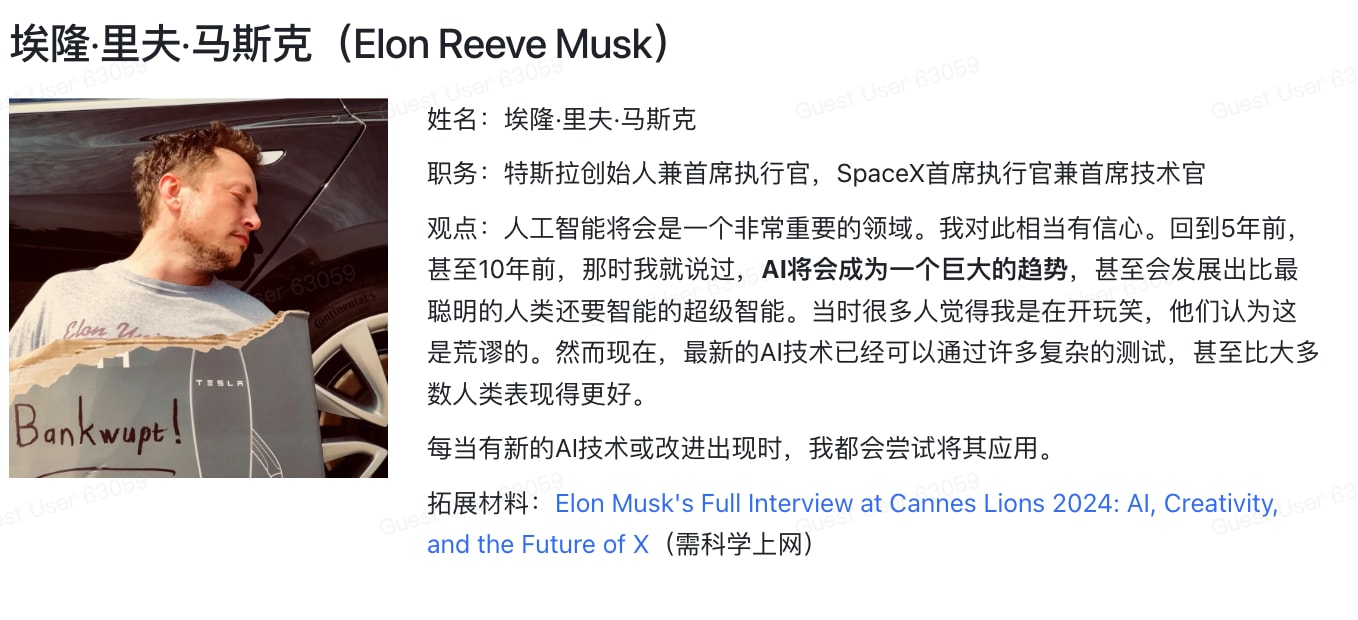
Despite many of these “leaders” being AGI-pilled, the ranking itself is not. With each leader having one selected quote to highlight their beliefs in AI, only two of the 26 selected quotes discuss AGI. Others focus on AI’s commercial promise, industry potential, and future trends. For instance, the selected quote from Liang Wenfeng, likely one of the most prominent voices in China advocating for AGI, is about open source as a strategy for both commercial value and brand reputation.
While hero-worshipping Silicon Valley leaders might be dismissed as superficial fandom, the community’s choice of information sources reveals deeper structural biases.
The section of “recommended foreign information outlets” has 129 sources, with 24 starred as must-read recommendations. Stratechery tops the list, while Lex edges out Dwarkesh. Most of the recommended sources have deep Silicon Valley associations, with one-third focusing on investment. The rest are C-suite executives or top researchers from big-name tech companies like OpenAI, Google, and Nvidia. Although some of the figures from big tech are AGI-focused, the list itself does not appear to be curated for AGI expertise. Rather, the even distribution of top profiles from big tech, mixed with prominent VC voices, reads more like a collection of Silicon Valley’s most commercially successful figures.
When we zoom out to the full list, the AGI flavor dissipates further. Among the remaining 105 sources, approximately 25-30% focus on investment, while 35-40% feature key figures from big tech companies and AI startups. About 15-20% come from U.S. universities, predominantly California institutions like Stanford, UC Berkeley, and Caltech. Around 10% consists of journalism and media outlets covering Silicon Valley and venture capital culture, while only a handful represent more independent technical sources like Stephen Wolfram, Nathan Lambert, Lex Fridman, Sebastian Raschka, and SemiAnalysis.6
Out of 129 total sources in a wiki titled “Way to AGI,” only three are explicitly AGI-focused: Eliezer Yudkowsky (founder of MIRI and LessWrong), Ben Goertzel (who helped popularize the term AGI), and John Schulman (chief scientist at Thinking Machines Lab and co-founder of OpenAI), with perhaps two others (Demis Hassabis and Ilya Sutskever) operating in AGI-adjacent territory. Thus, if one wants to “study AGI” through these sources, they are probably learning how big names in Silicon Valley think about AI. And while Silicon Valley thinks about AI in many ways, the most appealing one to this community seems to be how AI can be used to make money.
But emulating Silicon Valley success requires significant time and capital investment. For users seeking faster returns, the wiki pivots from Western voices to Chinese practice: offering step-by-step guides for building and monetizing AI products domestically. Eager novices come here for quick profits, while the “AI pros” they aspire to become are simultaneously seeking to profit from them.
Following the “syllabus” of this wiki, the first step is an introduction to AI, where it uses “what is ChatGPT…and why does it work” as a basic guide. From there, you then learn how to install and subscribe to ChatGPT (step-by-step from how to register a Google account to how to add your credit card, and of course, using a VPN7). There are seven “must-read” entry-level documents, six of which are Chinese translations of English sources, from the book “What Is ChatGPT Doing … and Why Does It Work?” to articles explaining transformer, stable diffusion, and diffusion models for video generation. The only original content is the seventh section, “Easily Understand 20 AI concepts,” which uses only two or three sentences in Chinese metaphor to explain each concept related to AI, from the chain of thought to the chatbot arena.
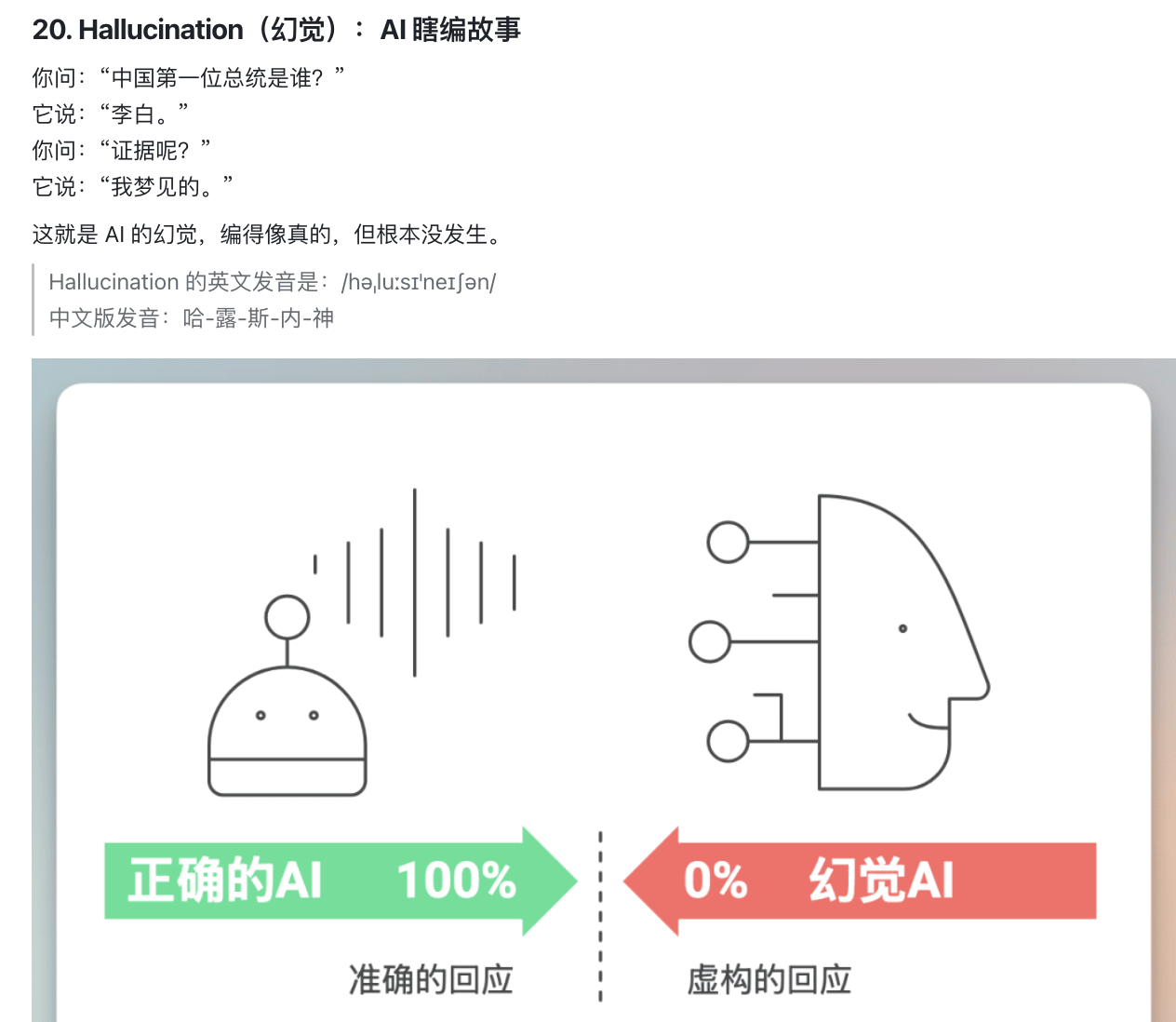
Not every introductory content is that introductory, but they are definitely “quick to learn” and extremely “practical”. You can master “Python + AI Without Coding Experience in 20 Minutes,” or know how to “gather LLM Data” through a 400-word article. For some reason, knowing how to select the best GPUs for model reasoning through comparing 38 kinds of Nvidia’s chips, including the H100 and A100, is also categorized as “entry-level content.”
After (supposedly) mastering these “introductory” concepts, you can then dive into area-specific learning: AI agents, AI drawing, AI video, AI music, AI character + audio combination, AI 3D, ComfyUI workflow, or AI coding. Let us take “AI agents”, which seems to be one of the trending focuses for developers on their way to AGI now. Here, you will start with a Chinese translation of Maarten Grootendorst’s A Visual Guide to LLM Agents.
Then you will read guides on how to create your own simple “AI agents” without any coding through ByteDance’s Coze platform by only prompting a few lines of description of the agent’s characteristics. The guide will not teach you to create the next autonomous system that can navigate complex real-world tasks. Instead, it mostly shows you how to build AI chatbots that act like a language teacher, or an AI workflow that generates outreach emails based on company profiles.
Interested in building, but have no idea what to build? There are loads of examples and analyses showing you the potential of integrating these “AI agents” into different real-life scenarios, as well as analyses of what’s trending in the AI agent market right now. Here, AI chatbots, workflows, and agents literally mean the same thing. Participation matters more than precision under the buzzing excitement of AGI.
After learning how to create your AI “agent”, you can participate in various “Agent co-learning pop-up contests (智能体共学快闪比赛)” to exchange with other people about how to build better bots/agents. Some smaller contests and workshops usually range from a few hours to a day online, with participants entering their own “agents” and experienced developers as judges to see who the winners are. Winners of these small skill contests receive a virtual certificate of “the coolest AI agent.”
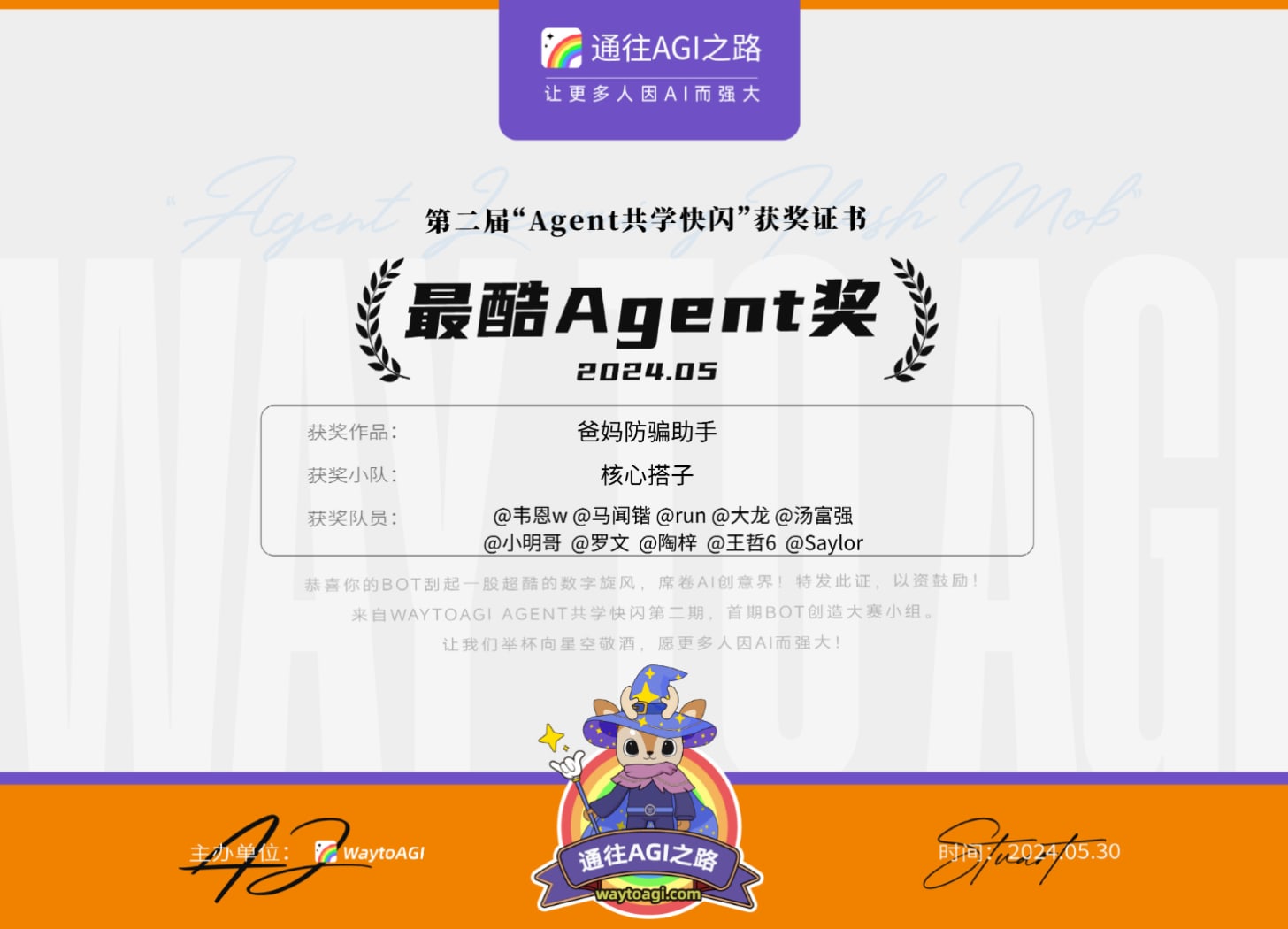
Meatier contests also exist, such as the “AI Agent Olympics 2025.” This “global” contest was co-hosted by Rednote, Weibo, Z.ai (which builds the frontier LLM GLM-4.5), and flowith.ai, with “Way to AGI” as one of the guest collaborators. Branding itself as “the first AI agent creation contest in 2025 worldwide,” the contest offers winners monetary awards (15000 RMB, or about US$2100) as well as social media exposure (via Weibo and Rednote). Despite sponsorship from Z.ai — the only AI startup in China openly claiming to be interested in AGI besides DeepSeek — and “Way to AGI,” there is no single mention of “AGI” on the contest website. Instead, the contest’s organizers state that “the rights to intelligence (智能) should not belong to any corporation, but instead should belong to a community of mankind (人类共同体),” with the last phrase strikingly similar to the CCP’s diction “a community of shared future for mankind (人类命运共同体).”
Don’t expect to see some crazily AGI-pilled individuals or the next DeepSeek founder in this contest. According to the bios of group members published on the platform, your peers will likely have some professional background related to AI, perhaps as a prompt engineer, as a product manager at a big Chinese tech firm, or as a full-stack developer. But you will also likely see people who were previously working as graphic designers, visual editors, or real estate agents — jobs that are very susceptible to AI replacement and were hit hard by China’s economic crisis — asking to form groups for related competitions. The poster of the AI Agent Olympics 2025.
The way to AGI may be important, but perhaps the way to money is more important. The final step tackles the question of how to quickly monetize your new knowledge. Massive materials on product management are available in this section: how to understand and create demand for agents, where AI agents integrate into companies’ workflows, and experiences shared by so-called “AI agent product managers.” However, even with this general knowledge, there is still a real gap between your immature “AI agents” and AI products that can actually earn money.
There are many “AI pros” who first offer some free learning materials claiming to fill that gap. They will share some introductory content that showcases the great potential of the AI agent market and how easy it is for people with no background to make a profit. Later, they introduce paid core lessons that they argue offer “systemic structure, professional guidance, personalized plans, and feedback” for more efficient learning. Effectively, this so-called “open-source AGI community” becomes the first step for some people to hook novices into their closed-source AI coaching business.
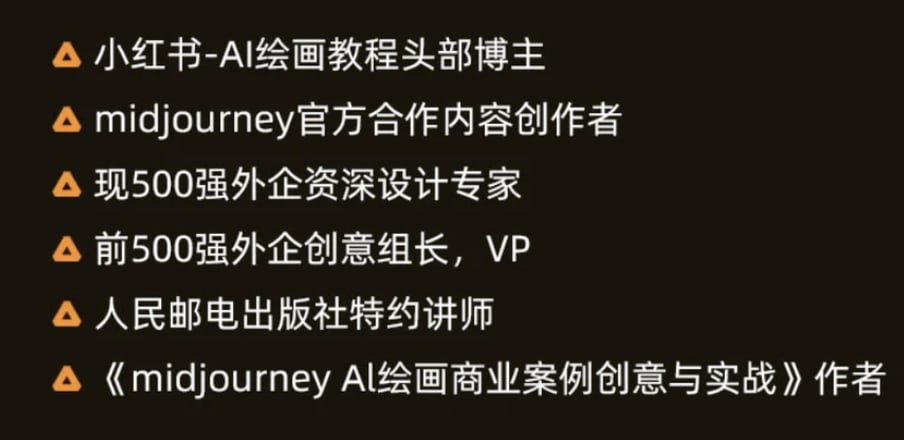
For example, in the AI Agent co-learning section, one member “shares” a piece of great paid content she “recently came across” (she is likely the person who runs the paid course). The screenshot below is how she justifies having paid for lessons (up to 5000 RMB/700 USD) in the open-source community: “It is like exercising in your home or going to the gym for guidance. Different people have different demands. The open-source community offers a wealth of resources suitable for disciplined self-learners. Recently, there have been many new entries to this community, and everyone is asking if there are suitable entry-level courses. Compared to learning from the text in the wiki, most people prefer the teachers to teach step-by-step.”
The emphasis on quick monetization comes at a cost. Buried beneath the layers of get-rich-quick content lie the remnants of more ambitious intellectual projects, which now serve as evidence of the roads not taken on the way to AGI.
This community did attempt serious scholarship. Early projects included comprehensive translations of Google DeepMind research papers, philosophical explorations tracing the concept of “agent” back to ancient Greece, and an ambitious database cataloging AI agent papers from research groups worldwide, complete with translated Chinese abstracts.
But these initiatives couldn’t compete with monetized content for sustained attention. The AI agent paper database, launched in mid-2023, aimed to index AI agent research papers, provide reviews, and translate English abstracts into Chinese, but was abandoned by December 2023.
Another abandoned project is the “Global AI Law Handbook (全球AI法规手册).” Originally conceived as an ambitious project to track, summarize, and translate AI-related legislation worldwide, it ceased updating Chinese regulations in mid-2024 and coverage of other jurisdictions by late 2023. Lost within its archived pages are translations of significant policy documents: the official EU AI Act interpretation from 2023, the UK Parliament’s pro-innovation AI regulation framework, Biden’s AI safety and security standards, and the Blueprint for an AI Bill of Rights. Some of these regulations remain active today; others, like the project itself, have been abandoned.
The handbook section has since pivoted toward narrower, more commercially oriented content — focusing on practical AI copyright guidance in China, including analysis of AI-generated artwork copyright disputes, while increasingly hinting at paid legal consultation services for users.
Perhaps the most telling irony of this massive “AGI wiki” is what’s conspicuously absent: any serious discussion of AGI itself. Among hundreds of documents covering everything from GPU comparisons to monetization strategies, only two articles specifically address AGI as a concept — both written by the same author reviewing industry trends in 2023 and forecasting those in 2024.
The 2023 review reveals the community’s priorities starkly: the author spent literally zero percent of the text explaining what AGI actually is, and dedicated one brief section to “the Road to AGI (迈向AGI之路)”, mainly to forecasting GPT-5’s 2024 release and near-AGI capability (both did not happen), synthetic data training, and emergent behaviors. Then he dives into five detailed sections on development trends and business opportunities.
The 2024 forecast still devotes its main content to analyzing business and investment trends in AI products. After devoting 75% of the article to business trends and 20% to geopolitics, the author finally begins to discuss how actors might control and monopolize AGI technology. However, this discussion ends up going nowhere, with the author pointing out how individual voices are increasingly unheard under grand narratives put forward to celebrate the promise of AI. “I don’t want to talk more about the problems of AGI, because there is no point simply talking about this problem.”
This article captures the irony of “Way to AGI” well. Even though this wiki is titled “Way to AGI,” serious analyses of AGI are packaged in massive amounts of business buzzwords to attract attention. Only glittering investment bubbles and Western tech jargon can survive along the way to AGI, while more serious learning finds no way out.
Rather than leading to AGI, this wiki serves as a way for individuals to feel empowered and hopeful by engaging in AI discussions driven mostly by business interests. The motivation that drives many to this platform — the economic anxiety from AI disruption and China’s macroeconomic recession — gets buried beneath the promise that “AI will reshape the thinking and learning methods of everyone, and bring them unprecedented powers.”
The deeper paradox is: while “Way to AGI” promises to empower people through AI and make the path to AGI accessible to everyone, the only serious discussion of AGI feels profoundly disempowered. The community’s only AGI analysis retreats from complexity and laments powerlessness in the face of larger forces. To some extent, this AGI wiki is similar to the AGI bar, where people indulge in bubbles and avoid reality. Perhaps only by avoiding serious engagement with AGI itself can people maintain the promise and excitement that AGI represents. The moment AGI becomes real, with its implications for power, control, and human agency, the bubble begins to burst.
ChinaTalk is a reader-supported publication. To receive new posts and support our work, consider becoming a free or paid subscriber.
Many documents were originally published on WeChat.
However, this figure should be interpreted with caution. The community’s definition of ‘active developers’ likely includes users who create AI-generated content (videos, audio, images) and those who use no-code/low-code AI tools, rather than exclusively traditional programmers.
Data obtained in September 2025.
It is likely that these relationships are not formal “collaboration” per se, but more informal and minor associations like sponsoring one event hosted by the community.
There is no clear evidence of how the ranking works. It is likely to complied and updated by a few original founders of this wiki.
Initial analysis conducted by Claude with some human double check from me.
Using a credit card online might seem like a basic skill for most Westerners, but it is not often encountered in China. People usually use other digital payment methods, mostly commonly scanning QR codes.

大家好,今天说说上周发生的几件事。这几件事放到一起,给人山雨欲来的感觉。这几件事不是跟中国人有关,就是跟中国人民的老朋友有关。
第一件事,是被美国通缉的中国毒枭张志东,逃亡了半个地球以后,被抓获落网,引渡到美国。他的毒品生意在墨西哥和美国,但他的毒品供应链源头在中国。第二件事,就是美国在委内瑞拉周边,完成军事集结,川普威胁对委内瑞拉境内目标进行军事打击。委内瑞拉是“中国人民的老朋友”,也是南美州欠中国贷款最多的国家。这20来年,中国总共借给委内瑞拉500多亿美元。因为委国经济崩溃,现在还欠多少没还,外界并不清楚。一般估计,至少还有一半没还。
中国加入世界贸易组织20多年,成了制造业出口大国,也成了犯罪出口大国。中国的官方喉舌中共党员疫苗不吹嘘中国的制造业出口,但不会报导中国的犯罪业出口。西方媒体也是这几年才开始大幅报导中国的犯罪业出口。中国出口的主要是三种犯罪,第一是电信诈骗,第二是走私人口,第三是贩毒。
我曾经在“诈骗国度”那期节目中,分析过为什么诈骗业在中国异常发达,成了中国市场的刚需。以前,中国诈骗业的主要针对中国人,所谓中国人骗中国人,没有引起外界注意。但这些年,因为诈骗业大举出口,开始危害全世界,成了西方舆论关注的一个大问题。
一周前,美国和英国采取联合行动,没收了中国公民陈志140亿美元的比特币资产,还有他在英国的所有财产。美国司法部以洗钱等罪名起诉陈志。陈志躲在柬埔寨,从事诈骗业。很多中国人收到的诈骗电话,就是他在柬埔寨的诈骗公司打来的。中国人都知道缅北中国人经营的诈骗园,大都是陈志诈骗模式的翻版。那些诈骗园是借中国的一带一路项目起家的。
中国向世界出口的第二大犯罪产业,是走私人口。也是一周前,美国国土安全部和几个州的警察联合行动,抓捕了一批在美国走私人口的中国人。他们属于中国人在美国成立的全国性犯罪组织,主要犯罪活动是组织偷渡,开按摩院,经营色情产业。
关于陈志诈骗案和国土安全部破获中国人口走私团伙案,我看到的美国主要媒体都在显著位置做了报导。
几天前,美国媒体报导了另一件情节曲折的中国人犯罪大案,揭开了中国出口的第三大犯罪产业,就是制毒贩毒。
中文世界都知道美国枪支泛滥,每年很多人死于枪击,但在美国,毒品的危害远大于枪支。2022年,美国有11万人死于吸毒;同一年,有48000人死于枪支,其中有27000人是开枪自杀。也是在同一年,美国有42800人死于车祸。这意味着,美国死于毒品的人数,比死于枪支和车祸的人数加起来还多。
美国的毒品有三大来源地,一是南美州,二是墨西哥,三是后起之秀中国。目前,在美国泛滥的几大毒品,主要有可卡因、海洛因、冰毒、芬太尼。其中,可卡因主要来自南美州;海洛因、冰毒,主要来自墨西哥;芬太尼主要来自墨西哥和中国。跟传统毒品可卡因、海洛因相比,芬太尼制造成本低,毒性强,成为毒品犯罪的新宠,迅速占领市场。
可卡因和海洛因都是从植物中提取。要提炼可卡因,必须种古柯树;要提炼海洛因,必须种鸦片。但制造芬太尼,只需要在实验室用化学品合成就可以,而中国是这种化学品的主要供应国。
大家好,几天前,高市早苗当选日本首相,成为日本宪政史上第一位女性最高领导人。有人说她是右翼,有人说她是极右。今天,我们先不讲她的政治倾向。我们讲一下她当选日本首相,这个现象本身,给外界传递出的信息。尤其是跟邻国的土皇帝相比,日本的第一位女首相,传递出的巨大信息反差。
高市早苗出生于1961年,年轻时比较叛逆,做过重金属乐队鼓手,喜欢骑重型摩托,可以说活力四射。她的学生时代,也正是日本活力四射的时段。
一位在日本做律师的朋友说,日本公路上的重型摩托越来越少了,说明年轻人的活力不如以往。这几年,我有几次在日本、台湾骑车、徒步。日本公路上的重型摩托的确比台湾少,当然比美国更少。而且,在公路上遇到的很多骑手,是中老年人,年轻人不多。
激情、活力,带一点点叛逆,这本来是年轻人应当有的样子。年轻是人生起步时段最宝贵的财富,如果没有激情、没有活力,没有一点叛逆,老实讲,等于人生刚开始,就白活了。
1990年代,日本经济泡沫破裂以后,对年轻人的打击是最大的。在任何国家都是这样,经济泡沫破裂,缺少财富积累,被深深套牢,又看不到未来的年轻人,是受冲击最大的群体。
30多年中,日本政界似乎也成了被套牢的一代,躺平-挣扎-得过且过-再躺平-再挣扎-再得过且过。整个日本似乎成了一个被套牢的国家。
高市早苗当选日本历史上第一位女首相,会不会是个解套的契机呢?现在做一个完全肯定判断,为时尚早。但从这几天,日本民众的反应来看,高市早苗至少让很多年轻人看到了解套的希望。
根据《读卖新闻》的民调,高市早苗内阁的支持率高达71%,其中她在40岁以下的年轻人当中,支持率高达80%,比她的前任高出5倍。她的前任,石破茂,在40以下年轻人中的支持率只有15%。
不仅在年轻人中,高市早苗拥有压倒性的支持率,而且在40-59岁的中年人中,她的支持率也高达75%,比前任高出2.5倍。她的前任石破茂,在这个年龄段的中年人中,支持率只有29%。
高市早苗跟外界对日本政治人物的刻板印象,形成鲜明反差。上面的民调数字似乎也在表明,日本民众,尤其是年轻一代和中年一代,似乎不愿继续被套牢,不愿继续生活在过去30年的死板轨道中。
高市早苗年轻时的经历——重金属乐队鼓手、爱好重机摩托,还有她狂放不羁的生活方式,加上一些跟年轻选民和中年选民情绪合拍的主张,让她脱颖而出。她鲜明的个性和叛逆经历——先是叛逆传统,然后又叛逆反传统,在日本那种高度秩序化的“建前”(tatemae)社会,给人眼前一亮的感觉。
高市早苗面临很多挑战,她的执政能力有待经受考验。在这方面,各种媒体都有分析,有猜测,也有预估。几个月之后,这些分析大部分会被证实或证伪,人们只需要一点耐心,就可以看到。
不过,有一点,现在就可以确凿无疑地讲,那就是,这样一位有个性的女性当选日本首相,所传递出的明确信息:一个人的价值,是多维度的,你可以有激情、有爱好、有野性的一面,这跟你最终承担严肃的社会责任,甚至成为国家领导人,并不冲突。
这对感觉自己被套牢,感觉压抑、迷茫的年轻人,自然充满吸引力。“活力四射”“出格”“叛逆”“直言不讳”,跟在体制内取得成功,不是非此即彼,不是二选一。你不需要为了进入体制,从小就变得循规蹈矩,装模作样,老奸巨猾,彻底磨平自己所有的人生棱角。这无疑是对“个性价值”的肯定。
从人口结构上讲,日本是个老龄化社会。在这个老龄化社会,一个曾经叛逆,曾经“酷”过的女性,依然能登上政治阶梯的顶峰。这说明,日本还没有老到彻底丧失生命力,尤其是跟那个土皇帝统治下的邻国相比。
看一眼北京那个面无人色的土皇帝,他手下那群面无人色的老男人,那种上去就不下来的原始落后的统治方式,给外界,给中国人,尤其是给中国的年轻人和中年人,传递出什么信息呢?
无条件的爱。
这个东亚人这几年刚听说,频繁讨论,却几乎没见过的东西。
但是我细细想过,我见过,也感受过。
我的姥姥,对我,对我弟弟,对我的表妹,有无条件的爱意,有丰沛的爱意。
我也不太明白,我听中文歌,看中文的文章,甚至听中国的明星接受采访,大家都在最深情地最高频提起姥姥,而非其它亲人。甚至我有所怀疑的是:会不会在中国人的世界里,无条件的爱意都只来自姥姥呢?
我在其它家人的身上,有感受到,我成绩越好,成就越多,它们越对我好,越爱我尊重我,以我想要的方式对待我。
在这一点我很知足,因为我的好多朋友,熟人,网友,目之所及的案例,好的成绩和成就,也换不来这一切。我换来了,满足条件,换得结果,我也很高兴,甚至很感动。
但是我姥姥,她不在意我的成绩。
我的家人吃饭的时候赞美我的成绩,我的聪明,还帮我添油加醋地向外传播,让我也获得其它人的尊重和赞美。
但姥姥对我,对我们的成绩似乎不怎么感兴趣。
我是一个记忆力很好的人,我甚至记得小时候蹒跚学步时候事情,记得我把插座当橘子(小孩是脑子不太好),把手放进插座被电到,全家人又惊又吓又想揍我让我长记性,又拿橘子给我吃安慰我。
还记得我在姥姥家村里冬天站在河边看别人挖河逮鱼,我看得痴迷掉进了河里,被捞起来后姥姥用她的棉袄把我裹紧。我醒来怕自己闯祸会挨揍,结果姥姥看着我哈哈大笑,我因为挨揍危机解除,也哈哈大笑。
我记得这么多琐碎的事情,但是不记得姥姥关心过我的成绩。要说姥姥是因为不怎么识字所以不关心,但是我同样目不识丁的奶奶就挺关心。
姥姥记着奶奶最深的一件事情是:我和弟弟跟着奶奶去赶集,没有吃饭,想吃烧饼,烧饼很便宜,但是无论我和弟弟怎么哀求和哭,奶奶都不给我们买烧饼吃。姥姥村里的人也来赶集,看到了这一幕,回去告诉了姥姥。姥姥想不明白,为什么要这么对孩子,从此一直念叨。
姥姥想尽一切办法和花样给我们做好吃的。韭菜盒子,烙饼,刀削面,水烙馍,水煎包,农村物资匮乏,但是姥姥会的花样奇多,很多我妈妈都不会(我爸更不行),所以我和我弟弟恨不得每个周末都步行跨越几个村去姥姥家,小小年纪就学会了徒步。
猪流感那一年,猪肉贵到离奇,我们都吃不起,已经一年没吃过饺子。姥姥就买了鸡皮,包成水煎包,给我们煎水煎包吃。鸡皮肥嫩油香,在水煎包里有五花肉的效果,我和弟弟大快朵颐,煎出一锅吃一锅,煎出一锅吃一锅。我们农村老家有一句话,奶奶常用来骂我们叫做:狗窝里搁不着剩馍。在姥姥面前,我和弟弟这两只饥饿的小狗,可以尽情地吃尽水煎包,而不怕被骂。
每年二月二龙抬头,娘家人都会来女儿家,姥姥就会给我们带来她做的面豆和糖豆,全村其它小孩家都没有,大家都只有每家每户都炸的爆米花。姥姥做的面豆非常好吃,干香嘎嘣脆,我们在其它地方从来没见过,就问姥姥怎么做的,姥姥总是骗我们说:是用脚丫子踩的。我们就边用牙齿咬石子一样硬的面豆,一边想脚丫子。
有一年二月二,我和弟弟就想早点见到姥姥和吃到面豆,大清早就出发去姥姥家,结果姥姥骑着自行车和我们走了不一样的路去我家,我们就在路上错过了。等到了姥姥家发现锁着门,去姥姥村里人群聚集的地方,外公在那里打麻将,旁边站着看牌的人和他说我们来了,他都没回头瞅我们,冷漠地说了一句话,旁边的人再大声喊着告诉我们姥姥去我们家了。我和弟弟孤零零站在大路上,看着那聚集的人群离我们很远很陌生,有些不知所措,像两个被人扔在路边的小面豆,楞了一会才转头回家,回家路上我们都很想哭。
我们回家见到姥姥和妈妈,又高高兴兴地吃上姥姥做的面豆,但是姥姥回家和外公大吵一架,因为她回家听别人说外公站都没站起来看我们,一直埋头打麻将(还是那个说奶奶不给我们买烧饼的人告诉姥姥的),姥姥生气地骂外公怎么能这么对小孩,让小孩难过,外公说:“我是长辈,我要维护长辈尊严。”我不喜欢把妈妈的父母叫做外公和外婆,仿佛妈妈的家人是外人。但是外公是我心目中的外人。
不仅仅是因为这次事件,而是因为他对谁都没有爱,有条件没条件都不爱。谁都不爱。对姥姥尤其糟糕,姥姥一生仅有的悲剧都由他造成。
我的姥姥是一个怎样的人呢?她是一个充满了主动性和生命活力活力的人。
我和小姨说,如果姥姥是我的同龄人,我不敢想象她会活得多么兴致勃勃,活力满满,成就非凡。
小姨说但凡姥姥上过学,肯定会是个企业家。其实我想说,姥姥没上过学,也已经是一个企业家,企业家所需要的创业精神,姥姥都有,倘若没有她这个丈夫拖后腿,她这一生不知道多辽阔和自由。
在我们皖北逼仄的乡村,姥姥的家里比我们家离城市更远更落后,姥姥养育了4个女儿和1个儿子和一个巨婴一样的赌鬼丈夫。我和大姨说我想给姥姥写一本书,大姨回我:好好写你姥的一生遇上你外公这个赌鬼。
即使是这样天坑一样的局面,姥姥依旧在坑里刨出不一样的东西:所有人都在安于在地里种小麦,玉米和大豆这些农作物,姥姥把全家十几亩地,开辟了苹果园,桃园和杏园,她带着孩子在还没有各种机动机械的时代,手动地耕种这些土地,种一些别人没有在种的东西,后来还种胡萝卜和红薯。
姥姥还是个游荡者,为了给家里挣钱,姥姥不远万里,在几十年前,不知道使用了怎样的交通工具,从连车都没有的贫穷皖北乡村,去了新疆捡棉花。我直到几十年后,从已经有高铁的皖北去了北京,再从北京坐飞机去了新疆,我都觉得远得堪比蜀道难。我无法想像姥姥是在没有电视的时代怎么听说世界上有新疆这个地方,又怎么在不识字的情况下获取到信息,能够成功抵达去新疆的。姥姥在几十年前去新疆的勇气,超乎我在如今环球游荡去了世界尽头的勇气。
姥姥不害怕这个世界。她遇到困难就解决,没有生路就刨出来生路。姥姥从新疆回来时瘦的皮包骨,几个月只挣了千把块钱,为了让孩子们能过得好一点。
姥姥也不像奶奶那样,因为自己受过苦,就再也没办法花钱满足孩子的需求。
我在三四岁的时候,有一次去姥姥家过年,大姨刚刚说好了对象,对象第一次上门,姥姥就请了穿着白色衣服,带着高帽子的厨师来给我们做饭,长长的桌子还铺着桌布,上面放着晶莹透亮的高脚杯,那一天我觉得自己简直活在电视里,梦幻的场景让我记到了如今三十多岁。这个事情妈妈,爸爸和大姨都忘记了,我和她们反复说起,她们才将将想起。
能让一个学龄前的小孩也拥有记忆,拥有梦幻的记忆,姥姥是这样的一个人。
强势,心气高,活力足,总是能发起和创造一些我们没见过的事情,还会爱小孩,尤其爱我们这些孙辈,我这么爱《从诗善开始》这本书,很大原因是沈诗善身上有我姥姥的影子。小时候家里穷,很少有衣服穿,姥姥就打开在江苏上大学的小姨的皮箱,把各种小姨的衣服都拿给我穿,每次小姨寒暑假回来,都对着自己的皮箱困惑。有时候我总觉得我妈妈和我的姨们,很吃亏,没有享受到姥姥充沛的爱意,在她们还是小孩的时候,姥姥必须独自撑起家庭,挣扎在温饱线上,对爱孩子有心无力。而我和弟弟和表妹,就赶上了好时候。
姥姥还有一个像沈诗善一样好听的名字,叫做石凤峦,岩石的石,凤飞九霄的冯,山峦的峦。我第一次直到姥姥的名字时,被这个名字的美震撼。它很像我喜欢的另一个名字葛薇龙,有薇这样柔美的字眼,也有龙这样气势磅礴的开阔,把轻柔的美和辽阔的美结合在了一起。凤峦这个组合,更加气象万千。一个岩石机理的凤凰,翱翔于山峦绵延之上。
姥姥的人生,本该如她的名字这样的。
不幸的是,她遇到了外公。
从姥姥和外公的吵架里,我大概猜测出了这个悲剧的起源。姥姥比外公小十来岁岁,外公是独子,丧父,在60多年前,中国还在建国后百废待兴,教育非常不普及的情况下,他考上了教育部认定了64所全国重点大学之一,安徽省当时第一名校合肥工业大学。当时的大学非常难考,入学率低于1%,而外公以一个农村考生,考上了全省最好的学校,成为了当地当之无愧的才子。但是好景不长,他遇到了当时的大饥荒,无法在学校饿着肚子求学,回到了起码有田地的乡村。
爱才子的叙事在中国流传的几千年,勇敢追求爱情的叙事也在建国后开始兴起,姥姥就不顾家人反对和这个比自己大了十来岁的才子在了一起。
除了我们已经熟知的这样叙事下的骗局和悲剧,更加悲剧的是当乡村教师的外公又遇到了十年动乱,被打倒,失去了教师的职业。而这个悲剧,笼罩了他的整整一生,他仿佛再也没有从这个悲剧里走出来,他接下来的人生,就开始为自己上访,从我开始记事起,他就一直在上访,在我出生之前,还有多年上访的日子。其余的日子,他就打麻将和赌博,来逃避自己失意的人生:那个本来自己的才华所允诺,但是却被时代的悲剧所摧毁的人生。
我不是不能理解这样的悲剧,我非常能理解。但是我不认为它是一个人还是选择创建家庭,却全然逃避家庭责任的理由。他把所有谋生,育儿和与家庭有关的一切责任扔给了自己的母亲和妻子,甚至女儿,还执着地要一个儿子,却不自己花时间养育儿子。我的爷爷的人生悲剧比外公更强烈:母亲死于淮海战役,有了后娘后就有了后爹,尽管亲爹是小学校长,自己却不被允许读书,被后娘用擀面杖抽打,冬天去河水里洗衣服,吃不饱饭,没获得过任何的爱意,但是当他成为父亲,成为爷爷,还是知道怎么对孩子好,对孙辈好,像我的姥姥那样给孙辈想方设法做好吃的。会因为孙女儿孙子儿吃不到别的孩子能吃到的好东西,而心痛流泪。爱人究竟是一种摧毁后就不可再生的能力吗?还是一种选择?姥姥,爷爷和外公给出的答案是不一样的。
姥姥一个人又主外,又主内,照顾5个孩子,一个婆婆和一个巨婴丈夫,还要面对和丈夫无休无止的争吵,和丈夫赌博输钱所带来的生活无法填补的漏洞。
在最后一次因为丈夫赌博而引发的争吵后,姥姥脑出血躺在了北方冬天冰冷的院子里,从晚上七八点躺到了第二天早上,才被罪魁祸首的丈夫发现,错过了最佳救治的时间。但是姥姥依然活了下来,小姨说在这种情况下姥姥还是醒来了,足以证明她的生命力和求生欲望强,说来说去她还是不放心自己的孩子们。但是姥姥从此以后只能坐轮椅,失去了自理能力和说话的能力。我当时读高中,去医院看姥姥,很不相信那么强势又充满活力的姥姥,以后只能这么活。之后我每次去看姥姥,姥姥都会大哭流泪,像一只被拔掉了翅膀还被囚禁的鸟,只能仰仗丈夫的照顾生活,而这样的一个丈夫,又对它者毫无照顾的意愿和能力,所以每次看到姥姥她都萎靡枯瘦。
每次我奶奶说起外公对姥姥造的这些孽,能把姥姥这样一个强量带派的人折磨成这个样子,我的心里就像被抽了鞭子一样。悲剧是把美好的事物毁灭给人看,也是把最有活力和生命力的人锤到无法站起。
我无法细想姥姥的故事,我怕无法从悲剧中把自己拾起来。但是我想对姥姥公平:我不能原谅一点点外公这个加害者。
在外公还在家里持续造成各种灾难,把妈妈和阿姨们气到崩溃时:我劝我妈妈和我小姨和我外公断绝关系。但是她们也觉得我的提议大逆不道,因为那毕竟是她们的父亲。
我没有这样亲缘关系的包袱,我只对我的姥姥公平,我怨恨外公这个加害者也决定之后不再记住它。
给与过它人爱意的人才值得被人深深铭记和常常怀念,而给别人频频带来灾难的人,记住他的人,只到因他而受苦却还被孝道绑架的儿女们为止了。
而我和我的弟弟和表妹,会记住我们的姥姥,我不会有子孙后代,不会再以人传人的方式把姥姥的故事传播下去,但是我会用我的创作,把你记下来,让互联网,让别人,也帮我记住你。
姥姥是在我去年游荡世界的途中去世的,我为姥姥感到宽慰,感到长舒一口气,她不自由的,被束缚在轮椅的,被丈夫苛待,无法表达所思所想,只能一次次看着亲人哭泣的生活,终于结束了。
而我在离开中国,前往荷兰前,和妈妈姥姥一起在家里共同生活了一段时间,妈妈择菜,我炒菜,我和妈妈给姥姥洗澡,我们以母系氏族的形态,进行了女性共居。我很感谢那些那段时间,我和妈妈还有姥姥如此紧密地相处。有一次姥姥突然昏迷,没有在我面前哭过的妈妈吓哭了,我第一次感觉自己成为了这个母系氏族的主心骨,打电话叫救护车,不知道救护车会不会来我们这个乡村,就满村子里找车想送姥姥去医院。后来再去接救火车,和妈妈姥姥一起去医院,安慰妈妈和跟医生沟通,再每天去医院陪床做检查,缴费报销买饭。我经历了一次救助姥姥的过程,没有让姥姥一个人躺在冰凉的院子里整整一夜,所以我没有遗憾。
在我游荡回来的31岁的生日当天,我要清早出发去南法游荡之前,我在凌晨3点做了一场梦,梦到我在游荡的路上遇到了年轻的姥姥,姥姥个字很高,头发乌黑,声音洪亮,我高兴地和姥姥聊天,还拍了一段视频,我问姥姥,你最喜欢吃什么地方的食物啊?我还和她说之后我会把这个视频剪好发给她。
凌晨三点我做了这样一个梦醒来时,我就带着微笑在流泪:倘若我会生一个女儿,我会姥姥会成为我的女儿,我再好好爱她。但是我已经决定了不会结婚和生育。所以姥姥来到了我的梦里,她说她可以成为我的朋友,成为我游荡中的朋友,和我一起看看这个她不曾害怕,却也未曾来得及游历的享受的世界。
我在将明未明的生日凌晨,再一次感受到姥姥对我巨大且绵长的爱意,她会在离开这个人世间的第一年,来到我生日的梦里,带来我宽慰,带给我希望,带来我不必遗憾只需向前的展望。这个爱意像一场笼罩了整片大地的雾气一样,让我的心一片也不漏风。
感谢你,姥姥,在我的生日这一天,来到我的梦里。
也感谢你在艰难人生中那些主动,那些发起,那些在地上播种些不一样东西的动机,那些前往异乡的勇气,感谢你的活力和生命力,我从你那里继承了很多。我时至今日,能成为一个创作者和游荡者,都要感谢你,曾经带给我的感染,启发,爱意和自由。我从你那里继承了这些美好的基因,我会带着它们前往更辽阔的世界,创作出别人的地里长不出来的东西。
前些天我在看《看不见的城市》这本书,作者假想马可波罗把自己看到的城市写给忽必烈。我就突然想到,我那本《一个蓄意的游荡者》的口袋书,可以以何种的方式继续。
之前我写着写着,就不知道自己在向谁讲述了,我脑子里的观众太多,我陷入了很多当下叙事的沼泽。而如今,我想把它变成《写给姥姥的游荡书》,我不必再向面目模糊的它者讲述了,我找到了我最想讲述的人。姥姥,我想把我去游荡过的地方,想把我想在那些地方偶遇的所在,写给你。
马可波罗不曾真正给忽必烈写过信,讲述那些看不见的城市。
但是我要给姥姥你写信了,写那些我曾游荡过的城市。我不相信玄学,但我很愿意想象人死后灵魂可以变成蝴蝶,从此遗世而独立,翩迁于世界。
而姥姥你的灵魂的这只蝴蝶,一定会在偶然间看到我给你的来信,和我想让你也看到的那些城市。
-本文亦以音频形式收录于放学以后播客《58 赛博亡灵节:我想和离开这个世界的人说说话》

前面有一期,我们讲了中国人一个历史悠久的的绝活,就是建墙。古代建长城,到了互联网时代,也要在网上建道墙,把自己的世界分成墙内墙外。从墙内看墙外的世界,如果只看官方宣传喉舌和各种民间肉喇叭,肯定会得出一个结论:美国要完,日本要完,欧洲要完。
墙不只是阻挡中国人的视野,而且也塑造中国人的三观和行为方式。很多从墙内出来的人,到了国外,也是背着墙出来,仍然是那种墙民世界观。他们来到美国,看美国媒体,发现美国真是太乱了,真得快要完了,跟墙内喉舌、肉喇叭说的一样,社会撕裂,种族对立,政客相互攻击,党派相互拆台,政治冲突不断,民众动不动就上街抗议…能不完吗?
几年前,有位在国内炒美股发了财的中年人,第一次来美国。问他对美国的观感,他说美国太乱了,治安不好,未来不好说。他应该算是比较有钱,而且是炒美股挣钱,但他对美国的观感,仍然是一个字“乱”。他能接触外界信息,不会只看墙内喉舌的宣传,也有钱有资源,这样的中国人看美国也是“乱”字当头,说不定要完,何况社会底层的中国人呢?
美国不是今天才这么“乱”。用中国人的标准衡量的话,“乱”是美国的常态。美国媒体报导的那些“乱象”,在美国一点都不新鲜,历史上层出不穷,现实中也司空见惯。但美国是不是真要完了呢?
中国这几代人有个执念,就是要赶上美国,超过美国。赶超有两种方式,一是自己强大起来,二是对方烂下去。墙内宣传喉舌也是抓住这两点编制出一套宏大叙事,这就是中国人都熟悉的“东升西降”。
这种宣传口号,其实一点也不新鲜。同一个宣传套路,只是换个包装,喊了好几代人。毛主席时代,叫“东风压倒西风”。当然,结果大家都知道了:“东风”把中国人压得,饿死了上千万。毛一死,国门一开,中国人猛然发现,原来“西风”吹来的国家比“东风”这里发达得多,生活水平高出好几个时代。
很多中国人,尤其是习惯了“大一统”和“稳定”思维的中国人,看到美国四年一大选、两年一小选,国会整天吵架扯皮,总统满嘴跑火车,街上动不动就抗议,就觉得美国“太乱了”。按照中国人对“乱”的本能恐惧,一觉得乱,自然就觉得“要完”。
这些年,看到一个现象,就是在中文世界,有很多人,无论是反美的还是崇美的,虽然骨子里都很看重美国,但又很少有人真的愿意花时间去学习和了解美国这个国家的社会、历史和政治。他们对美国的理解,大部分来自墙内宣传喉舌、中文自媒体、各种民间肉喇叭、好莱坞电影,还有一些中文媒体的二手报道。
但是,如果了解一点美国历史,再看美国今天的政治冲突,比起它过去经历的几个剧烈动荡期,顶多算是“毛毛雨”。这个国家从建立之初,就充满了各种深刻的矛盾。但恰恰是这些矛盾,提供了巨大的张力,成了它不断变革和发展的动力。
明年是美国建国250周年。《华尔街日报》开设了一个专栏,名叫“USA250”,专门讲美国历史上的重要事件、各种发明创造、各种政治现象,能读英文的听众,可以去读一下。如果能读进去,肯定会对美国当今的社会和政治有更理性的认知。
“USA250”最近一篇文章分析了美国社会从建国到今天,一个一以贯之的核心矛盾,就是——民主与资本主义的矛盾。今天,我们就以这篇文章为蓝本,结合中文世界的情况,来讲讲这个持续了近250年的矛盾,如何塑造了今天的美国。这对于我们看清当下美国的“乱”,至关重要。这也有助于我们理解,中国土皇帝“东升西降”那种说法是怎么回事。
Last month, Irene and Lily went to South Korea to report on a twin set of robotics conferences. Here are a few notes from their travels.
Irene:
Hallyu — the “Korean Wave” of pop culture that began spreading internationally in the 2000s — taught my generation of Asian Americans/Canadians how to style ourselves. We grew up with few relatable points of reference in mainstream Western culture, as our physical features rarely aligned with American beauty standards. K-pop built an alternative, affordable framework during our coming-of-age, and it was impossible to miss its influence even if you (like me) never consumed much of the music or TV dramas.
Goryeo (the royal dynasty that ruled the Korean Peninsula from 918 to 1392) began sending women by the hundreds as tributary gifts to the Chinese empire during the Tang dynasty. The Middle Kingdom, from then on, routinely scoured the Peninsula for beauties. The third Ming emperor, Yongle, was recorded to have favored a concubine surnamed Kwon from Joseon (the dynasty that followed Goryeo). After Kwon died at the age of 20 in 1410, the Yongle Emperor sentenced perhaps thousands of women from his harem to death on suspicion of poisoning Kwon, according to one Korean chronicle.
Japan’s colonial rule forced between 50,000 and 200,000 Korean girls and women into sexual slavery as “comfort women” for the army. After the Second World War, another vast sex trade sprang up around American-led army bases across South Korea, with girls and women trafficked by their own government to provide “morale” to UN troops and bring in millions of foreign money for the economy.
Beauty remains one of Korea’s most prominent exports. Multilingual advertisements for plastic surgery sprawl throughout Seoul’s affluent Gangnam neighborhood. There is seemingly an Olive Young on every street corner and endless high-end options in shining department stores. The industry works hard to conceal the dark historical context behind Korea’s coerced preoccupation with female beauty, while continuing to push what sociologist Rosalind Gill calls the “surveillant gaze”: symbolic images of measuring tapes, cameras, and microscopes that incite women to constantly monitor and regulate themselves. K-pop labels routinely debut girls as young as fourteen to appeal to teens, both locally and internationally. Appearance-based discrimination is endemic; journalist Elise Hu writes in Flawless: Lessons in Looks and Culture from the K-Beauty Capital that for Korean women in the 21st century, looking pretty is “the price of entry in the labor market.”
Lily:
I’m a size small in America, a medium in Taiwan, and a large in South Korea.
For a country with such a famous beauty industry, the selection of lip colors and finishes is extremely limited. Nearly every Korean lip product is sheer, glossy, and pink, formulated to stain your lips for a longer-lasting effect. Eyeshadow palettes lack pigment and are similarly uninspired. While American makeup brands market their products as tools of self-expression, cosmetic advertisements in Korea use words like “perfection” 완벽 and “improvement” 개선 to draw consumers’ attention.
Korean sunscreen, however, is excellent, as are the face masks and jelly foundation cushions (provided you can find one in your shade). The products are very affordable compared to American cosmetics. I browsed many Olive Young stores that were packed with shoppers, yet the single aisle dedicated to American and European brands was always totally desolate.


Similarly, people seem to prefer beige or pink nail polish. I got a set of dark red gel nails done during my trip, and while the service was very fast with lots of attention paid to cuticle care, the final product was unfortunately lacking due to the technician’s lack of experience shaping stiletto (pointed) nails.
People don’t wear much color here either, and instead opt overwhelmingly for beige, white, black, brown, or muted shades of blue.
Korea excels at making coffee taste good, and Korean people love coffee so much that we saw people sitting in cafes drinking coffee at 9 o’clock at night. In a similar vein, this country doesn’t rise particularly early — most businesses (including many coffee shops/cafes) don’t open until 10 or 11 am. Survey data indicates that South Koreans are highly sleep-deprived compared to other developed nations.
October is the peak month for gejang, raw crab seasoned with soy sauce. I was skeptical at first, but the crab we ate was incredibly fresh with a delicate and complex flavor.
One of my favorite dishes was North Korean-style cold noodles 물냉면, which are made of buckwheat and would fall apart if served hot. They come with julienned apples and a boiled egg, and are served in a refreshing broth with a bit of vinegar.
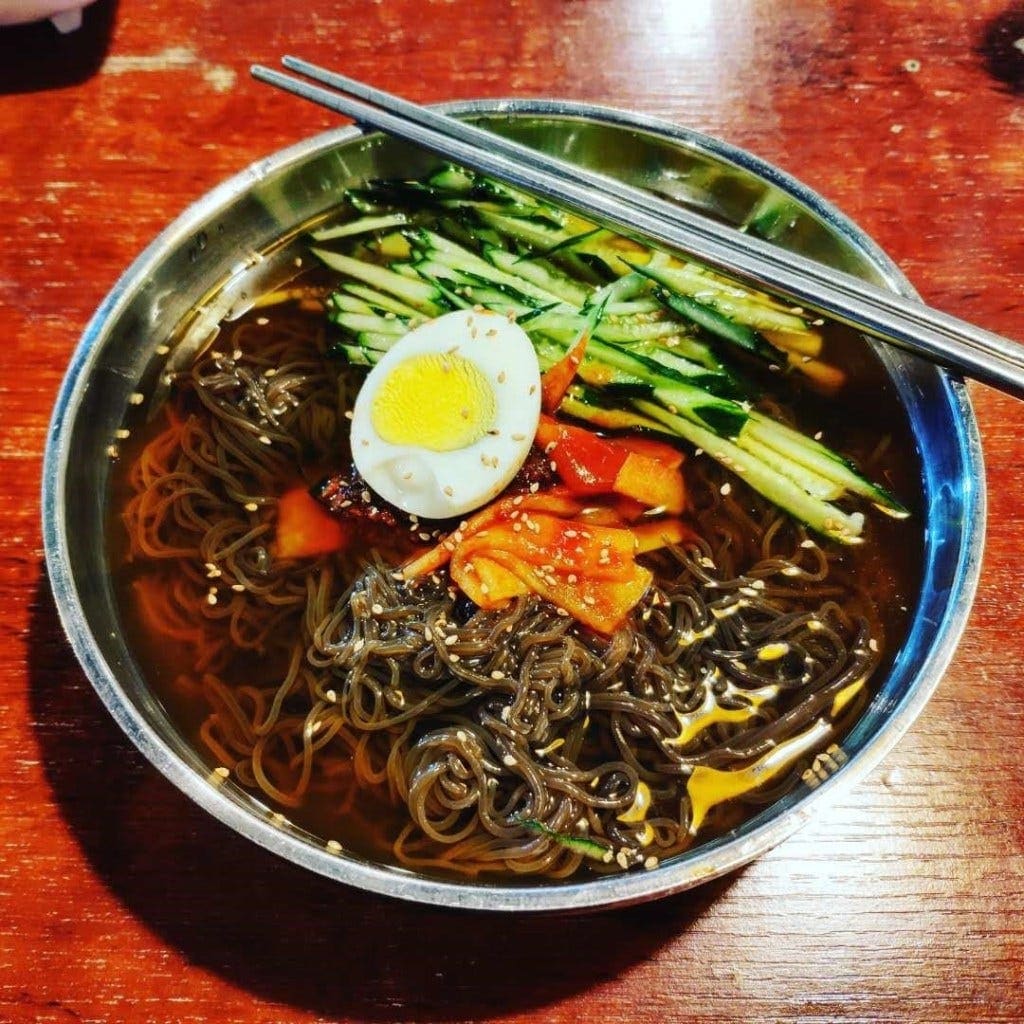
America supplied the ROK with food aid during the Korean War, and as a result, South Korea developed a serious taste for corn. Convenience stores carry cream-filled cornbread, corn-flavored ice cream, corn-flake-filled granola bars, corn chips, and rice balls full of corn and tuna. Teas made from roasted corn and corn silk are also popular beverages. Only 1% of this corn is actually grown in Korea — the vast majority is imported from the US.
Korea also consumes a truly staggering amount of fake sugar — ice cream proudly labeled “low sugar” is packed with stevia. The yogurt drinks and matcha lattes I ordered in cafes were sweetened with stevia by default, as were bottled teas and protein shakes in convenience stores.
Korean convenience stores have wonderful smoothie machines. For 3,000 KRW (US$2.10), you can pick out a cup of frozen fruit and have it blended in front of you. Be sure to purchase your fruit cup before you blend it to avoid violating smoothie procedure.
Chinese people have a joke that when you vacation in Korea, you get constipated due to the lack of green leafy vegetables. This joke ignores Kimchi and salads, of course — but it’s rare to find blanched greens of the sort that are ubiquitous in China and Taiwan.
I read Anton Hur 허정범’s 2022 short story “Escape from America” on the bus from Seoul to Gwangju. The great translator of contemporary Korean fiction writes his own dystopian tale: in a not-so-distant future, politics force him and his husband to flee America for South Korea, where democracy persists but their marriage is not recognized — a “reverse-Miss Saigon scenario,” the narrator notes sardonically. Fears of martial law, borders, gender wars — it all felt eerily prescient in the first months of new presidential administrations in both Korea and the US.
Korea’s Gwangju Uprising is often forgotten as an early chapter in the waves of pro-democracy movements that shaped postwar Asia. In part, that’s because the news simply didn’t get out. Only one Western reporter — Jürgen Hinzpeter for West Germany’s public broadcaster, whose experience was dramatized in 2017 by the film A Taxi Driver — was on site when troops began violently containing protesters on May 18th, 1980. Korean media was heavily censored at the time, and many outside South Jeolla Province, of which Gwangju was then the capital, did not learn of the killings until much later. The military dictatorship installed an effective blockade of the city for ten days, cutting off roads and phone lines, while local students and workers built a short-lived self-governance commune and organized themselves into citizens’ battalions.
Chun Doo-hwan 전두환, then-lieutenant general of the military and the main orchestrator of the massacre, officially became president three months later in 1980 and remained in power until 1988. For years after the massacre, Gwangju was a forbidden topic. The novelist Han Kang 한강, who became Gwangju’s most famous daughter with her Nobel Literature win in 2024, was in Seoul in 1980 and only found out about the atrocities from her father’s secret album of Hintzpeter’s photographs years later. The official death toll stands at 164 civilians, but many more disappeared or were not identified in time; the actual number of deaths may be in the thousands. An “unknown martyr” grave in the Gwangju May 18 National Cemetery contains the body of a 4-year-old child shot in the neck.
“That afternoon there was a rush of positive identifications, and there ended up being several different shrouding ceremonies going on at the same time, at various places along the corridor. The national anthem rang out like a circular refrain, one verse clashing with another against the constant background of weeping, and you listened with bated breath to the subtle dissonance this created. As though this, finally, might help you understand what the nation really was.”
— Human Acts, Han Kang (trans. Deborah Smith)
The “gwang”/광 in Gwangju corresponds to the Chinese character 光, which means light; Gwangju, then, is the Land of Light. I’ve never been to a city with as many commemorative statues as Gwangju. There is an entire park dedicated to statues in the western part of the main city, the government having commissioned artists to explore and immortalize the city’s history. A walk through the park crescendos with a large metal depiction of three students, their arms reaching forward and their faces bearing solemn expressions in a surprisingly socialist-realist style. Under their bodies is an entrance to an underground chamber, in which the names of all known victims surround another statue, this one of a mother holding the body of an agonizingly young teen — a modern Korean Pietà.
Gwangju is not just expressive about its past; it is passionately, thoroughly meticulous. The Jeonil Building, one of the city’s most iconic structures, has been renamed Jeonil 245 after the 245 bullet traces found on its top floors. The directions and depths of each trace conclusively prove that paratroopers shot at people from helicopters, a fact often disputed by those seeking to minimize the extent of cruelty inflicted on Gwangju’s people. Jeonil 245 contains an entire exhibition dedicated to repudiating false claims about Gwangju, including the oft-repeated far-right conspiracy that North Korea instigated the uprising. The nearby 518 Archives is a ten-floor building that houses documents about the events of May 1980. The top floor allows visitors to watch traffic underneath from the exact same windows where Catholic clergymen watched the military brutalize young students marching from Chonnam University. Some of those clergymen would later stage hunger strikes for democracy and clemency for protestors throughout the 1980s. The Old South Jeolla Provincial Hall, where resistance forces staged their last desperate fight, is currently being restored. Every single exhibit I went to was free to enter and had decent-to-excellent English signage.
This is because Gwangju knows its memory can be inconvenient. In the South Korean narrative, Gwangju’s dead are now martyrs who gave their lives for today’s democracy, but that extraordinary achievement does not feel complete. President Yoon Suk-yeol 윤석열, who demanded the death penalty for Chun Doo-hwan while a law student in the 1980s, briefly imposed martial law of his own in December 2024. Korean politics today, haunted by the North-South division, still struggles to move past Red Scare paranoia. On the American side, Washington’s complicity in the Gwangju Massacre is a delicate topic for the US-ROK alliance. President Jimmy Carter’s administration, judging maintenance of the security status quo in the Peninsula to be more important than its people’s democratic aspirations, authorized the use of South Korean troops under the Combined Forces Command against protestors. Declassified documents show that US intelligence judged the protests to be “riots” caused in part by “deep-seated historical, provincial antagonisms” in Jeolla, and feared exploitation by Pyongyang even without any evidence of North Korean instigation. Gwangju became one of the darkest, yet most obscure, chapters of the Carter years; the legacy he left in Asia was barely acknowledged when he passed away at the end of 2024. And finally, across the East China Sea, Gwangju strikes too obvious a parallel with China’s own event that must not be named. Han Kang’s Human Acts has never been translated into Simplified Chinese by any mainland publishing house, so Chinese readers have to resort to pirating the Taiwanese translation.
Efforts by public history institutions and civil society have allowed the year 1980 to persist in Korean popular memory, even before Han Kang’s recent Nobel win. UNESCO officially listed documents of the Gwangju Uprising on the Memory of the World Register in 2011, prompting a wave of public commemoration. In 2013, the K-pop boy band SPEED released a two-part music video set in Gwangju for their song “That’s my fault” 슬픈약속, to popular acclaim. Note how, at the 11:30 timestamp mark, the second video directly quotes the last broadcast made by Gwangju’s citizen militia at the end of the Uprising:
Protest songs from the Gwangju era have also outlived the Uprising. March for Our Beloved (임을 위한 행진곡), the most well-known one, is now a social movement ritual across Asia, having been adapted by activists in Hong Kong, Taiwan, Thailand, and mainland China for a variety of causes. Citizens in Seoul once again sung it while protesting Yoon Suk-yeol’s martial law declaration in December 2024:
Gwangju today is known as Korea’s progressive hotspot, and there is indeed a Portlandia-esque energy coursing through the city. Hipster cafes, lush green parks, and private museums weave around statues of death and survival across the city’s main arteries. The central square, where protestors gathered again to call for the ousting of Park Geun-hye 박근혜 during the 2017 Candlelight Revolution, doubles as a futuristic plaza for the Asian Culture Center (ACC), which showcases experimental art from across the continent. I visited on a rain-drenched day, and there were still large crowds at the ACC enjoying a pan-Asian food festival and open-air dance film screening. The ACC’s ten-year anniversary exhibition, Manifesto of Spring, sports a headline piece with a brassy premise: in a not-too-distant future, democracy collapses in the West and a political refugee tries to immigrate to “Seoul Land” by participating in a population growth program.
The Land of Light, like the rest of us, is surrounded by the haunted fires of history. It insists on sifting through the ashes.
“Why are we walking in the dark, let’s go over there, where the flowers are blooming.”
ChinaTalk is a reader-supported publication. To receive new posts and support our work, consider becoming a free or paid subscriber.
Lily:
Seoul is an underrated tourist destination. The city is full of beautiful green spaces connected by excellent public transit, and the early October weather was perfect for long strolls through the sloping streets.
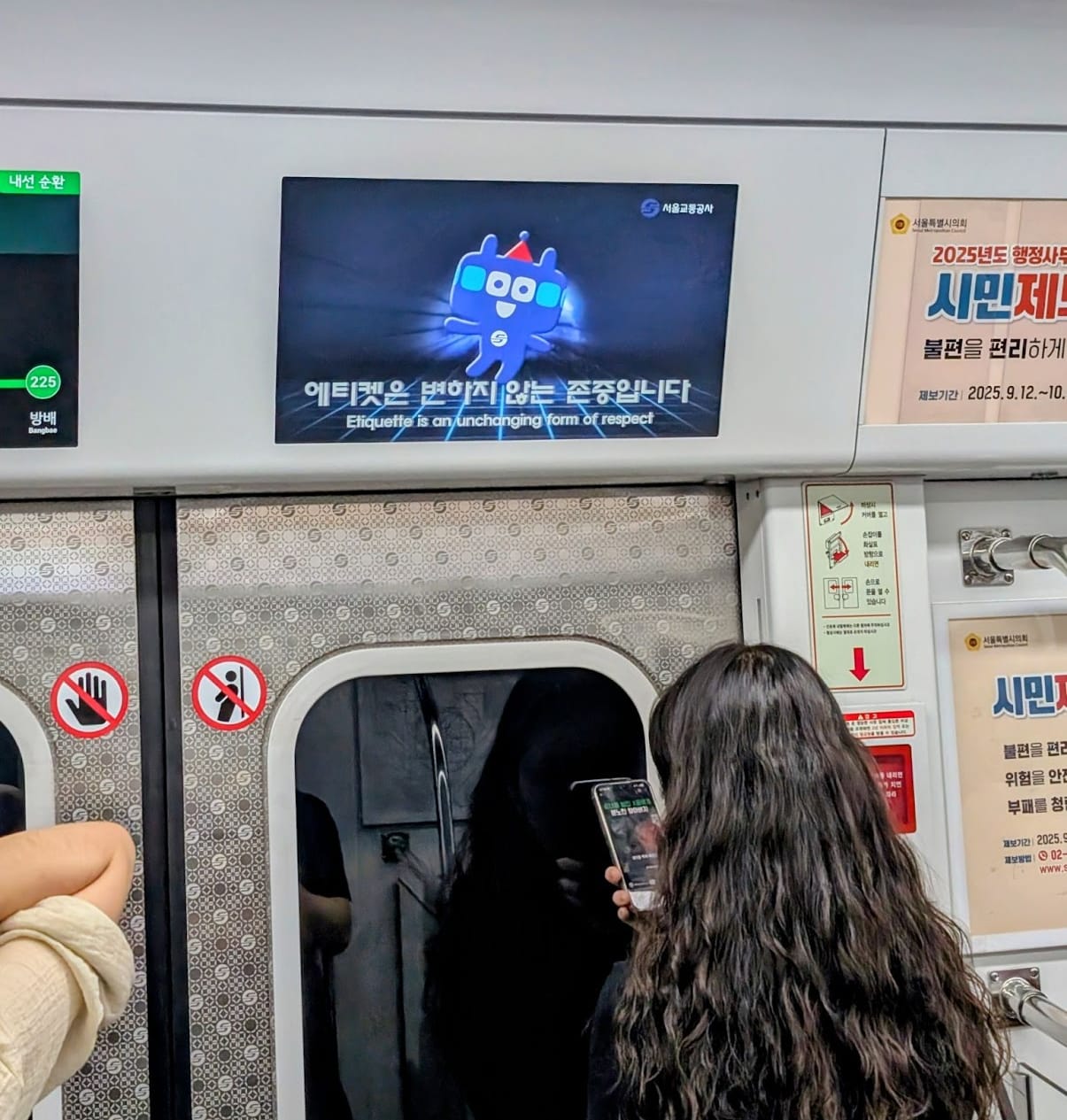
The Korean writing system is a joy to learn, and just a little bit of study can really enrich your experience in Korea. It’s phonetic, and the letters elegantly fit together to form syllable blocks. The shape of the letters is also roughly based on the shape of your mouth when pronouncing each sound (for example, “ㄱ” makes a hard “g” sound, “ㄴ” makes the “n” sound, and “ㅈ” makes the “ch” sound). Irene and I had a great time sounding out menu items, buttons on appliances, and public transport signs, discovering tons of cognates with Chinese in the process. If you add a Korean keyboard to your phone, you can use the letter “ㅗ” to give someone the middle finger over text, and represent crying faces with “ㅠㅠ” and “ㅜㅜ”.
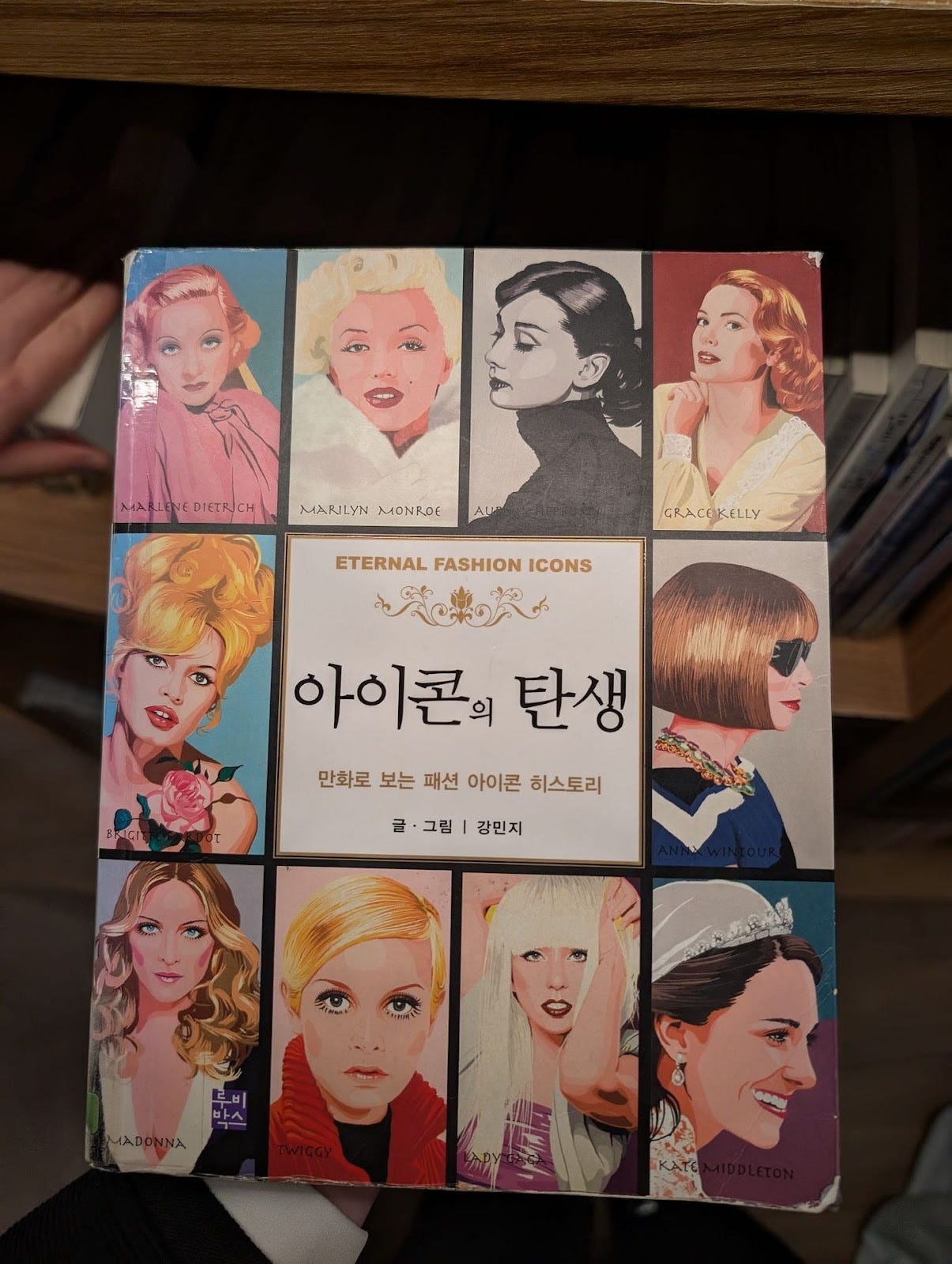
这个世界绝大部分节日是给活人的,有一些节日是给半死不活的人的,只有非常稀有的节日,是给已经离开这个世界的人的。我们向神祈祷,供奉祖先,对鬼恐惧,避之不及。逝去的人在我们的脑中变成了不同的形态,我们很少与之对话,总是要么祈求要么远离。在这个死气沉沉的时代,在这个尸斑传染的线上空间,我们想创造一个节日让大家和真正的死人说说话。
这是一个赛博亡灵节,我们一起举办一场赛博法事,不仅超度亡魂,也超度一下死感很重的自身。和已经逝去的人说说话,朋友,家人,先贤哲人,某个遥远的历史人物,某个喜欢的创作者,甚至可能会突然离开人世间的自己,我们把想说的话用手机录制下来,集结成音频,用创作的火光把它烧给提早离开的人。
(本期播客封面:莫不谷用canva创作)
【Timeline】
05:48 发起这期播客的缘起:为什么我想要办一场“赛博亡灵节”?
15:29 如何理解“如何呢 又能怎”这句时代之音?一次线上尸斑检测
18:41 霸王花作为还活着的人身上的死感:在人生最年富力强的阶段却常常乏力,疲惫和倦怠
22:43 金钟罩的问题:为什么霸王花看这么多年心理医生都没有用?莫不谷找到的答案和办法
27:13 为什么我不承认自己有解离?为什么别人看起来荒谬离奇的事情,我自己却并不知道
31:24 为什么评论区总说“在线确诊为霸王花”?这个世界并不真的存在巨人国
36:23 莫不谷:做这期播客很核心的原因,姥姥在我游荡路上去世了,我想读一读我写给她的信
01:09:55 霸王花:9月我去了伦敦大S的纪念长椅,看望大S后我想和她说的话
01:14:10 莫不谷写给大S徐熙媛的信:《这个世界可爱的人不多,你是其中重要的一个》
01:21:00 发人深省的精彩网文:当女性帮助献祭男性时,她的运势就会被吸取
01:24:00 朱媛媛溘然离世:这个世界没有一个女性克夫,但每一个丈夫都克妻
01:30:00 莫不谷:我决意在此时此代,就充分探索我的才华,让我的生命活力带着才华往上奔涌
01:37:57 金钟罩:假如我突然离开了,想给自己和这个世界说的话
01:42:50 一个脱口秀演员的故事:只要你发现造物主给你送的礼物,人生好多问题就迎刃而解
01:49:46 霸王花:为了改善抑郁,焦虑和精神痛苦,我去英国寺庙咖啡馆打工换宿一个月
01:59:50 为什么我们要给自己选择一个健康可持续的环境?当中式“卷王”遇上欧式随意
02:03:20 莫不谷:为什么我对Ta人命运过度热情,因为我对自己的生命非常非常有热情
02:07:00 赛博烧纸和莫不谷基金:倘若万一我不小心离开了世界,我想留下来的话
02:16:28 离奇震撼的听友来信,霸王花不敢相信,但莫不谷非常相信的真实故事
02:20:08 如何提前安排自己的遗产?关于女性遗产捐赠基金的设想和发起
02:30:04 大声说出你的发起,你会收到世界的回声,生命活力就会由此增强
02:34:08 霸王花:假如我突然离开了,想要留给这个世界的两句话
02:36:00 金钟罩和霸王花给这个世界该死却没死的人说的话
02:40:47 莫不谷:我创建一个网站,目的就是促进那些该死的人早点去死 www.boomlaodeng.nl
02:49:34 欢迎投稿放学以后Newsletter新的专辑:赛博哭墙,让我们一起虚拟抱头痛哭一次
【放学以后游荡者保温杯预售意向统计】大家可以考虑自己的实际需求,需要的可以填写链接选择预购意向,小红书或飞书链接均可,无需重复填写,如需了解保温杯拆箱视频,可到小红书主页“游荡者的日常”查看,统计截至10月30日结束!
【播客&文章&影视&书籍】
播客:
放学以后播客《莫路狂花2:如何对自己充满爱意和敬意,免于混乱逃避低活力?》
放学以后播客《莫路狂花今夜不设防:人如何不糊弄和痛恨自己,并找到自己的渴望呢?》
放学以后播客《终身学习1:学会面对真问题,不逃避,下决心和谈分离》
放学以后播客《我们一起Gap一个冬天,再用这些火焰召唤一下2025年!》
岩中花述播客《要走多少路,才能成为一个女人,答案在风中飘荡》
文章:
解锁放学以后《创作者手册:从播客开始说起》:https://afdian.com/item/ffcd59481b9411ee882652540025c377
解锁莫不谷《做一个“蓄意”的游荡者》口袋书:https://afdian.com/item/62244492ae8611ee91185254001e7c00
莫不谷Newsletter文章《当铺天盖地的不确定性一起袭来时,人会惊见自己的弹性》《复仇是治愈伤害的特效药:boomlaodeng》《价值投资:在中国或欧洲投资美股美债的原因及方法》《从《财富自由主义》到比特币,自由的上限是我们持续学习的能力》《这个世界可爱的人不多,你是其中重要的一个》《赛博烧纸和莫不谷基金》(游荡者网站和爱发电也可查看)
莫不谷游荡者“每周一游”专栏文章《独居省钱终生自豪的邪修技能:给自己剪头发!》
霸王花Newsletter文章《活出美妙人生的可能:出门看看自己究竟喜欢什么?》《在秋天尝试新的可能:来英国寺庙咖啡馆打工换宿》《我的夏日奇遇:那些让你感觉碎掉的时刻,不是真的》(游荡者网站和爱发电也可查看)
霸王花游荡者文章《低成本游荡世界的方法:我如何找到包吃包住的打工换宿机会?》
韩国作家河马文章《参政是治愈空虚的特效药》
影视:《破地狱》;《精神病房也会迎来春天》;《延禧攻略》;《哈利波特》;《【一更到底】全文时长70分钟已完结 权谋/脑洞/大女主/爽文/古代》
书籍:《佩德罗·巴拉莫》;《三国演义》;《看不见的城市》
【为全球华人游荡者提供解决方案的平台】
游荡者(www.youdangzhe.com),注册后可免费阅读由莫不谷和霸王花撰写的三篇文章(Run的800种可能、语言攻略和全球签证攻略),目前游荡者已更新上线文章分区功能(游荡区、学习区、欢愉区和闲聊搭子区),还上线了付费咨询功能,欢迎大家注册后开启内容创作并在游荡者游荡愉快!找到同类!交易自由!手机端用户可把新网址添加桌面,便于日常使用。使用新网址期间如果有任何注册、支付、退款等需求,欢迎给我们客服邮箱wanderservice2024@outlook.com发送邮件。
我们还发起了游荡者平台线上游轮活动,我们作为“导游区”成员(莫不谷、霸王花木兰,粽子、金钟罩,有时还会邀请朋友客座)将每周轮值担任船长,在国内时间每周四更新一篇【每周一游】,分享内容包括但不限于各种花花万物和生命体验的推荐和避雷!在临近周末打工人即将解放的周四,和大家一起驶向一些海域打发时间,度过无聊,对抗虚无!欢迎各位游荡者每周四定期登船!
【为全球华人女性复仇发起的凤凰社】
www.boomlaodeng.nl 这是我发起的微小的凤凰社,构建的微小的广场,投掷的有可能有风险或者尴尬的石子。就是这样的一个东西,我也有勇气邀请你的加入:邀请你这个格兰芬多的成员,这个开启baby step的参政公民,这个下决心爱自己救自己的个体,邀请你的加入,写下你的曝光。
相关文章:《复仇是治愈伤害的特效药:boomlaodeng》
【延伸信息】
永不失联Newsletter订阅链接:https://afterschool2021.substack.com/(需科 学/上 网)
为全球华人游荡者提供解决方案的平台:游荡者(www.youdangzhe.com)
联系邮箱:afterschool2021@126.com (投稿来信及合作洽谈)
同名YouTube:https://www.youtube.com/@afterschool2021
同名微信公众号:放学以后after school
小红书:游荡者的日常
B站:游荡者的日常
欢迎并感谢大家在爱发电平台为我们的创作发电:https://afdian.com/a/afterschool
片头曲:《寄生兽》Bliss
片尾曲:《No Cares Era》Valentina Ploy
插曲:《About Love》Dmitry Krasnoukhov、《Faylinn》David Hicken
播客封面:莫不谷用Canva制作
放学以后表情包:微信表情包搜索“放学以后”,感谢萝卜特创作。
播客收听平台:
【国内】爱发电、网易云、苹果播客(请科学/上网)、喜马拉雅、汽水儿、荔枝、小宇宙、QQ音乐;
【海外】Spotify、Apple podcast、Google podcast、Snipd、Overcast、Castbox、Amazon Music、Pocket Casts、Stitcher、Radio Public、Wordpress
I spent two weeks around the Bay Area in September. What follows are my reflections.
Dreamers encouraged. Writes Didion, California is “out in the golden land, where every day the world is born anew. The future always looks good in the golden land, because no-one remembers the past. Here is the last stop for those who came from somewhere else, for all those who drifted away from the cold, and the past, and the old ways.”
On the East Coast, if you start a conversation about the new thing you’re building, the first five questions you’ll get will be about how it won’t work. After experiencing the Bay Area energy, my wife decided that she could found a company and has spent the past month furiously vibecoding.
I’ve been bugging a prominent SF-based podcaster to do more political coverage with little success. I get it now. The weather is too nice, nature too inviting. I heard some light H-1B chatter, but we’re in the AI boom times, there’s too much tech to be excited about to get too worried about something as normie as the state of the Republic. And thanks to Lurie, homelessness is now tamed enough to make the poors someone else’s problem again.
DOGE energy is defensive to a level I haven’t come across in people politically involved before. The mantra that “DOGE is net positive and anyone who doesn’t agree can go fuck themselves” seems pervasive for anyone who’s stuck it out. Honestly, it’s understandable cope for the young SWEs who signed up to improve government services but ended up getting blamed for (/actually) taking vaccines away from babies. It’s striking that many people in the tech right I met say that good things are happening but that early DOGE really set back the one thing they have the most context on.
I was last in SF in 2023 and on that trip spent an afternoon at OpenAI’s office. Even six months after ChatGPT dropped, it still felt like a plucky research lab, albeit one with money for Tartine pastries and a lobby cueing off the Amazon Mr. and Mrs. Smith reboot aesthetic.
It’s now Meta, complete with the novel addition of door guards with American flag eyeglass straps and general SOF energy who will under no circumstances let you tailgate into the building.
The best neighborhood is the Presidio, a federal land run by a trust that keeps the park nice, new buildings out, and serves as a great landlord for hedge funds. One guy who worked there said a main draw was that “it’s federal land so none of that homeless shit flies here, baby!” It’s gorgeous but should probably be YIMBY’d out of existence. If Trump ever truly splits from the Elon/Thiel nexus, it would be a great troll move to throw some Trump Towers on top of their family offices.
Banyas, Berkeley, and South Bay
I went to a Slate Star Codex meetup at Lighthaven. There was an EUV lithography textbook lying around, so I read that, spotted Aella crocheting, and chatted with Pradyu about the Singaporean economy. A twenty year old told me he was founding DoorDash for Swaziland (“It’s pretty developed so it makes for a great beachhead”). Sam Kriss said something ahistorical about political violence and it started to rain so I went home.
The next day, I did not have the energy to make it to the banya, so deputized voice-of-a-generation JASMINE SUN to report:
The sauna visit is planned in an 87-person Signal chat with strict attendance enforcement. It’s inspired by the Jewish “schvitz”—a Yiddish word that can also mean “to sweat” or “to be nervous” or “to persevere”—but here describes the ritual of men gathering in steam rooms to gab about politics and business. Our host isn’t actually Jewish, but rather a garrulous New Yorker who self-identifies as spiritually so. He often invites acquaintances to schvitz within 15 minutes of talking. I find him very persuasive.
At 8:30pm on a Monday, I take a $24 Uber to Archimedes Banya in the far southeast of the city, then pay $67 to enter for up to three hours. If your last experience in a sauna was at a Korean-style luxury jjimjilbang, with unending plates of tiled dragonfruit and crab-in-the-shell, featuring nap pods and pool tables and rooms of pink Himalayan salt, the rawness of the SF Archimedes Russian banya experience will come as something of a shock.
It’s crowded on a weekday night. It has a clothing-optional policy, heavy on the optional; you’re guaranteed to see skin of all ages and genders and kinds. The staff are gruff and only speak in a yell. The hot room is extraordinarily hot. If you happen to be wearing jewelry, you’ll soon feel it burn. A steady stream of sweat pours down from my chin to my collar. Next to us, a hairy man lies face-down getting whipped by a prickly bundle of branches and leaves. He’s paying extra for this service. I try not to look.
I’m here with a troupe of nine 20-somethings. Seven are men and half work at a16z. The host is eager to share various snippets of banya lore: Did you know the Warriors come sometimes? Ilya used to play chess here. Have you read the n+1 piece about our New York schvitz? Apparently the New York chapter is more bond talk and less AI; another person says he’s “raising funds” for a DC venue. The host reminds me that he’s turned down several reporters’ requests to attend, but I’m just a lowly Substacker, which grants me a slot.
We discuss the NVIDIA lobby, the state of media, and the Chinese century. “You’ll never hear me say a bad word about China,” one says, waist deep in the pool. “[David] Shorism is Maoism,” another adds without elaboration. We then implore a visiting East Coast friend to move to SF. “This is the only place where anything happens,” we say with the confidence of people who really believe it. He says he’ll do it if he gets a job with the Lurie administration. “But he hasn’t texted me back.”
A friend apologized for the “off-road experience” after I pulled onto his Berkeley side street. “It’s scheduled for a 2027 repave!”
With Airbnb practically illegal, I used Kindred to book a place in Northern Oakland for what came out to $50 a day. I had a great experience on the platform and highly recommend it. Referral link here.
Berkeley Bowl is overhyped. I see the novelty of fresh pistachios and fourteen apple varietals, but if the cost is rotting fruit and $18 black lives matter bread loaves, I’m fine buying at Whole Foods, where grocery spend helps to underwrite AI chip demand! Also, Union Square Cafe blows Chez Panisse out of the water.
Berkeley is integrated into a city, while Stanford is a country club that keeps the plastic on its furniture. It’s set back from its town, which is oriented not at college kids but 50-something VCs. A state school with 10k undergrads per grade compared to Stanford’s 1,700 gives the Berkeley campus so much more life. The kids seemed to be having more fun, not stressed about software jobs disappearing before they graduate. And Stanford campus having a Rodin’s Gates of Hell sculpture creaking every few minutes is terrible energy.
Palo Alto’s library had a book sale of primarily Asian language titles. My favorite sighting was a textbook for national-level competitive high school chemistry in Chinese. At the playground, I heard mostly Beijing accents having anxious-brag conversations about their kids’ education.
The South Bay’s suburbs, bland food, and perfect weather felt as alienated from the rest of the country as the perfect suburb dug underground in Hulu’s Paradise. Marin, though, offers an endgame lifestyle.
Mill Valley houses nested in hills gave off Oahu suburb energy, accented by backyard redwoods. The town, one friend quipped, “boasts the highest ratio of black lives matter flags to black lives in the nation!”
We drove out to an elk reserve at the tip of Inverness. It felt like Altus Plateau from Elden Ring.
On the road back, we stopped at Point Reyes and had perfect pastries in the lavender garden of a bakery. Next to it was a small park that doubled as a NIMBY temple celebrating all the farmers that the Marin Agricultural Land Trust had subsidized to stay operating. One property they were particularly proud of saving from houses has “breathtaking reservoir views, easy access to major highways, and residential zoning.” Thanks to MALT, cows instead of humans will get to enjoy that view!
This trip was partially a test to see if we wanted to move to the Bay. Even with two weeks of perfect weather, I’m not sold. Hiking and utopian energy does not outweigh a real metropolis, community, and family.
My first day back, I had a meal at Cafe Mono (with a very friendly ML researcher who dropped in from SF), checked in on the Met’s China collection, and saw a superlative production of The Brothers Size. Better luck next time, California.
Bay Area food and ‘hiking with stroller’ recs behind the paywall. One includes a croissant that my wife said “tasted as good as the one I had immediately after giving birth.”
ChinaTalk is a reader-supported publication. To receive new posts and support our work, consider becoming a free or paid subscriber.

周末了,说点有意思的,说说朋友圈。一个人到底能维持多大的朋友圈?一百两百,一千两千,还是上万?这在有互联网以前不是个问题。一个人交往的范围有限,面对面交朋友,连酒肉朋友都算上,也不至于多的数不过来。有了互联网以后。尤其是有了社交媒体以后,情况就不一样了。Facebook、微信,朋友圈可以成百上千,成千上万。这里还不是说粉丝,只是说朋友圈。
但是,一个人真能维持那么大的朋友圈吗?人的所有行为都受到大脑限制。即使一个人想有成千上万个朋友,他的大脑能容纳得了吗?
上周看报纸,《华尔街日报》有篇文章,专门讲这个问题。人的大脑进化到今天,能维持的真正朋友圈,仍然有个人数上限。即使在社交媒体时代,人们也无法突破这个上限。那么,这个上限到底是多少呢?是十几个、几十个,还是几百个?我们下面慢慢讲。
社交媒体不是个真实世界,而是个虚拟世界,a virtual world。它制造了很多假象。朋友圈就是它制造的一大假象——一个人,朋友圈有几百人、上千人、上万人,好象他就有几百、几千、几万个朋友。这是社交媒体制造的假象。
社交媒体朋友圈的朋友,大部分只是一个数码。现代心理学表明,即便一个人想交几千几万个朋友,他的大脑也没有那种能力。不仅如此,社交媒体上的朋友圈越大,反倒让人在现实生活中,越没有朋友,越觉得孤独。
这种现象在社交媒体流行之前。其实已经存在。只不过,那时候大部分人的交往圈子没有多大,感觉不到这种反差。有些社交圈子很大的人,像一些电影明星,在社交媒体流行之前,他们就有这种感觉:周围人来人往,好像有很多朋友,但其实却没有一个真正的朋友。有明星还因为这种事儿自杀。
好莱坞有位喜剧演员,Robin Williams。他演艺生涯相当成功,有无数粉丝,无数朋友。大约十年前,他突然自杀了,生前留下一句话:“我曾经以为人生最惨的是孤单。现在知道,那不是最惨的;人生最惨的是,身边人来人往,却让你觉得孤单。”身边人来人往,好象朋友无数,但其实又都不是朋友,夜深人静的时候,发现自己其实是孤单一人。
社交媒体兴起来之前。普通人没有机会过这种身边人来人往的生活。只有电影明星、政客身边人来人往。社交媒体兴起来之后,每个人都可以在虚拟世界建个朋友圈。普通人有了这种机会,好象朋友突然多起来了。但是,在社交媒体这种虚拟世界,连人来人往都说不上,顶多算有些互动。甚至,大部分连互动都没有,只是一个数码对另一个数码,连朋友圈的大头像,很多都是经过数码处理的。
数码不是朋友。朋友需要有温度、有感觉。而我们的大脑能容纳的,这种有温度、有感觉的朋友,数量有个上限。
《华尔街日报》这篇文章就是根据近年的研究,揭示了那个看不见的朋友圈上限。这也可以说,是普通人社交能力的上限。不管一个人的社交能力有多强,很难突破这个天花板。这就像是我们大脑进化出来的一个出厂设置。